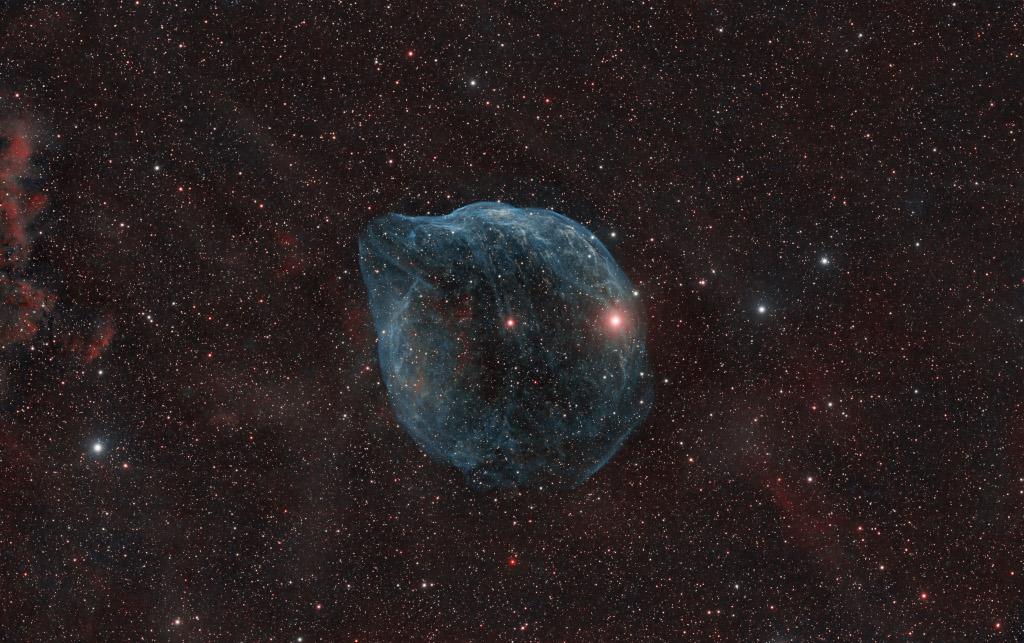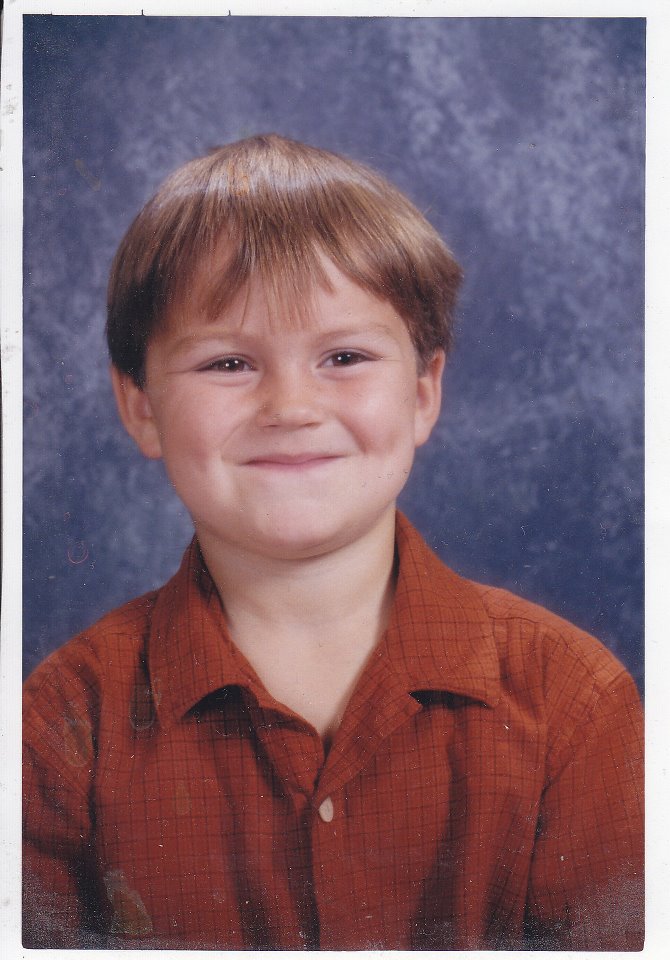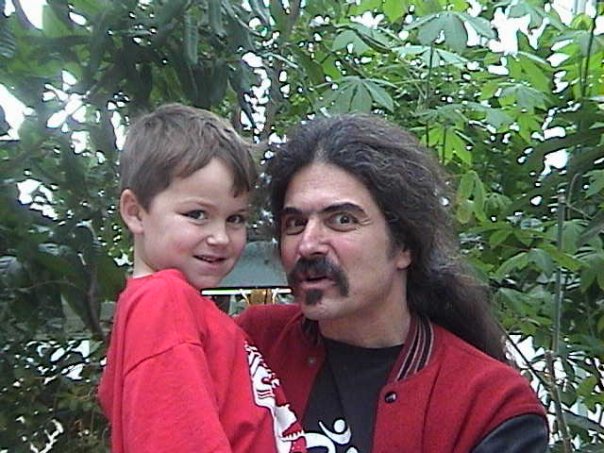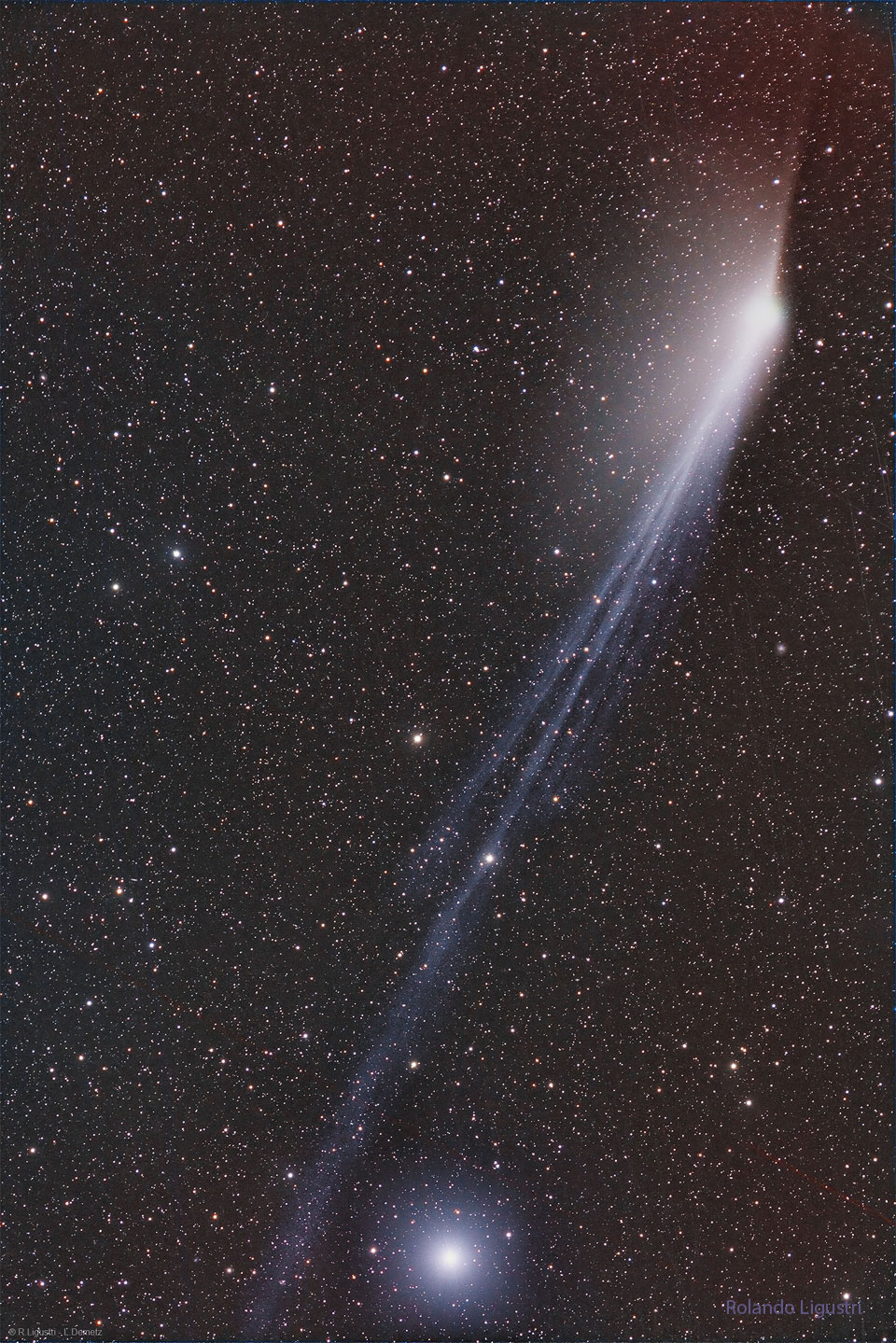Blog
Erev Shabbat Service with Celebration of Board Leadership and Farewell to Rabbi Moss
Friday 6-7-24 6pm Shabbat Erev Service celebrating Tobias Moss work at Temple Israel and his farewell new adventure working at a synagogue in Vienna, Austria. I sat in with Tobias Moss group Jewbalayla last summer and he made it so much fun. Tobias is a real inspiration and talent that bring a unique and generous blessing to his community. Accompaniment by Jayson Rodovsky, Jeff Bailey, Peter Whitman and mick LaBriola.
more...
Cataloged as Sharpless 2-308 it lies some 5,000 light-years away toward the well-trained constellation Canis Major and covers slightly more of the sky than a Full Moon. That correspondsto a diameter of 60 light-years at its estimated distance. The massive star that created the bubble, a Wolf-Rayet star, is the bright one near the center of the nebula. Wolf-Rayet stars have over 20 times the mass of the Sun and are thought to be in a brief, pre-supernova phase of massive star evolution. Fast winds from this Wolf-Rayet star create the bubble-shaped nebula as they sweep up slower moving material from an earlier phase of evolution. The windblown nebula has an age of about 70,000 years. Relatively faint emission captured by narrowband filters in the deep image is dominated by the glow of ionized oxygen atoms mapped to a blue hue. Presenting a mostly harmless outline, SH2-308 is also known as The Dolphin-head Nebula.

more...
Jonathan Paul Clegg, OBE OIS (7 June 1953 – 16 July 2019) was a South African musician, singer-songwriter, dancer, anthropologist and anti-apartheid activist.
He first performed as part of a duo – Johnny & Sipho – with Sipho Mchunu which released its first single, Woza Friday in 1976. The two then went on to form the band Juluka which released its debut album in 1979. In 1986, Clegg founded the band Savuka, and also recorded as a solo act, occasionally reuniting with his earlier band partners. Sometimes called Le Zoulou Blanc (French: [lə zulu blɑ̃], for “The White Zulu“), he was an important figure in South African popular music and a prominent white figure in the resistance to apartheid, becoming for a period the subject of investigation by the security branch of the South African Police. His songs mixed English with Zulu lyrics, and also combined working class African music with various forms of Western popular music.
Clegg was born on 7 June 1953 in Bacup, Lancashire, to an English father of Scottish descent, Dennis Clegg, and a Rhodesian mother, Muriel (Braudo). Clegg’s mother’s family were Jewish immigrants from Belarus and Poland and Clegg had a secular Jewish upbringing, learning about the Ten Commandmentsbut refusing to have a bar mitzvah or even associate with other Jewish children at school. He moved with his mother to Rhodesia (now Zimbabwe) at age 6 months, and his parents divorced soon afterwards. At age six, he moved to South Africa with his mother, also spending part of a year in Israel during his childhood.
He grew up in Yeoville, then a predominantly Jewish inner city neighbourhood of Johannesburg. He encountered the demi-monde of the city’s Zulu migrant workers’ music and dance. Under the tutelage of Charlie Mzila, a flat cleaner by day and musician by night, Clegg mastered both the Zulu language and the maskandi guitar and the isishameni dance styles of the migrants. Clegg’s involvement with black musicians often led to arrests for trespassing on government property and for contravening the Group Areas Act. He was first arrested at the age of 15 for violating apartheid-era laws in South Africa banning people of different races from congregating together after curfew hours.
more...Nii Moi ‘Speedy’ Acquaye, percussionist: born Accra, Ghana 7 June 1931; died London 15 September 1993.
SPEEDY ACQUAYE was one of a long line of African musicians whose presence in Britain since at least Elizabethan times has provided a cogent reminder of modern music’s rich and diverse origins.
For over 40 years his challenging remarks and gap-toothed grin were as familiar around Soho as many of the quarter’s better-documented denizens. But in Britain’s careless tradition of paying scant attention to the individuality of black people, he often experienced anonymous status. Those who knew him and his sturdy drumming knew better. Born in Accra in what was then the Gold Coast, Acquaye played a small drum, a parental gift, before starting school at 12. Teenage bands and encouragement from an older cousin failed to interest him in a musical career and he joined the Army briefly before heading for England. Pantomime (Man Friday in a Nottingham production) provided his show-business entry, London the stimulation for the rest of his life.
Soho in the 1950s teemed with small black clubs; here Acquaye found fellow Africans and local modern jazz players who admired their music. He worked with the saxophonists Tubby Hayes and Ronnie Scott and the redoubtable drummer Phil Seamen, then followed other African percussionists into Kenny Graham’s adventurous Afro-Cubists.
more...Harold Floyd “Tina” Brooks (June 7, 1932 – August 13, 1974) was an American jazz tenor saxophonistand composer best remembered for his work in the hard bop style.
Harold Floyd Brooks was born in Fayetteville, North Carolina, and was the brother of David “Bubba” Brooks. The nickname “Tina”, pronounced Teena, was a variation of “Teeny”, a childhood moniker. His favourite tune was “My Devotion”. He studied harmony and theory with Herbert Bourne.
Initially, he studied the C-melody saxophone, which he began playing shortly after he moved to New York with his family in 1944. Brooks’ first professional work came in 1951 with rhythm and blues pianist Sonny Thompson, and in 1955 Brooks played with vibraphonist Lionel Hampton. Brooks also received less-formal guidance from trumpeter and composer “Little” Benny Harris, who led the saxophonist to his first recording as a leader. Harris recommended Brooks to Blue Note producer Alfred Lion in 1958.
Brooks is best known for his recordings for the Blue Note label between 1958 and 1961, recording as a sideman with Kenny Burrell, Freddie Hubbard, Jackie McLean, Freddie Redd, and Jimmy Smith. Around the same period, Brooks was McLean’s understudy in The Connection, a play by Jack Gelber with music by Redd, and performed on an album of music from the play on Felsted Records, a session which also featured Howard McGhee.
more...Talmage Holt Farlow (June 7, 1921– July 25, 1998) was an American jazz guitarist. He was nicknamed “Octopus” because of how his large, quick hands spread over the fretboard.
Talmage Holt Farlow was born in Greensboro, North Carolina, United States. He taught himself how to play guitar, which he started when he was 22 years old. He learned chord melodies by playing a mandolin tuned like a ukulele. He said playing the ukulele was the reason he used the higher four strings on the guitar for the melody and chord structure, with the two bottom strings for bass counterpoint, which he played with his thumb. His only professional training was as an apprentice sign painter. He requested the night shift so he could listen to big band standards on the shop radio. He listened to Bix Beiderbecke, Louis Armstrong, and Eddie Lang. His career was influenced by hearing Charlie Christian playing electric guitar with the Benny Goodmanband. He said he made his own electric guitar because he could not afford to purchase one.
Farlow employed artificial harmonics and tapped his guitar for percussion, creating a flat, snare drum sound or a hollow backbeat like the bongos. His large, quick hands earned him the nickname “The Octopus”.
He caught the public’s attention in 1949 when he was in a trio with Red Norvo and Charles Mingus. In 1953, he was a member of the Gramercy Five led by Artie Shaw, and two years later he led his own trio with Vinnie Burke and Eddie Costa in New York City. After getting married in 1958, he partially retired and settled in Sea Bright, New Jersey, returning to a career as a sign painter. He continued to play occasional dates in local clubs. In 1962 the Gibson Guitar Corporation, with Farlow’s participation, produced the “Tal Farlow” model. In 1976, Farlow started recording again. A documentary about him was released in 1981.
Later in his career Tal performed as a member of Great Guitars with a DVD released in 2005 after his death.
Farlow died of esophageal cancer at Memorial Sloan-Kettering Cancer Center in New York City on July 25, 1998, at the age of 77.
more...Solea usually played por medio (on the sixth string in E phyrgian, relative to the capo) and at a slow tempo – commonly around 90 beats per minute. Solea performance also often involves rubato, the expressive speeding up and slowing down of tempo at the discretion of the performer.
The compas of solea emphasizes the 3, 6, 8, 10, and 12 beats:
1 2 3 4 5 6 7 8 9 10 11 12
Solea is sometimes called “mother of palos.” Though it is not the oldest (siguiriyas is older), there are a number of palos that derive their compas from solea include solea por buleria, the palos in the cantiñas group, like alegria, romera, mirabra, caracoles and, to a certain extent, buleria.
more...
Magnificent spiral galaxy NGC 4565 is viewed edge-on from planet Earth. Also known as the Needle Galaxy for its narrow profile, bright NGC 4565 is a stop on many telescopic tours of the northern sky, in the faint but well-groomed constellation Coma Berenices. This sharp, colorful image reveals the galaxy’s boxy, bulging central core cut by obscuring dust lanes that lace NGC 4565’s thin galactic plane. NGC 4565 itself lies about 40 million light-years distant and spans some 100,000 light-years. Easily spotted with small telescopes, sky enthusiasts consider NGC 4565 to be a prominent celestial masterpiece Messier missed.

more...
Anthony Frederick Levin (born June 6, 1946) is an American musician and composer specializing in electric bass guitars, Chapman Stick and upright bass. He also sings and plays synthesizer. Levin is best known for his work with King Crimson (1981–2021) and Peter Gabriel (since 1977). He is also a member of Liquid Tension Experiment (1997–1999, 2008–2009, 2020–present), Bruford Levin Upper Extremities(1998–2000) and HoBoLeMa (2008–2010). He has led his own band, Stick Men, since 2010.
A prolific session musician since the 1970s, Levin has played on over 500 albums. Some notable sessions include work with John Lennon, Herbie Mann, Sarah McLachlan, Paula Cole, Stevie Nicks, Pink Floyd, Robbie Robertson, Paul Simon, Lou Reed, David Bowie, Joan Armatrading, Tom Waits, Buddy Rich, The Roches, Todd Rundgren, Seal, Warren Zevon, Bryan Ferry, Laurie Anderson, Kate & Anna McGarrigle, Gibonni, Chuck Mangione and Jean-Pierre Ferland. He has toured with artists including Paul Simon (with whom he appeared in the 1980 film One-Trick Pony), Gary Burton, James Taylor, Judy Collins, Carly Simon, Peter Frampton, Tim Finn, Richie Sambora, Ivano Fossati, Claudio Baglioni and Lawrence Gowan.
Levin helped to popularize the Chapman Stick and the NS electric upright bass. He also created “funk fingers“, modified drumsticks that attach to the fingers of the player in order to strike the bass strings, adding a distinctive percussive “slap” sound used in funk bass playing. In 2011, Levin ranked # 2 behind John Paul Jones of Led Zeppelin in the “20 Most Underrated Bass Guitarists” in Paste magazine. In July 2020, Levin was ranked #42 on the “50 Greatest Bassists of All Time” list by Rolling Stone magazine.
more...Montgomery Bernard “Monty” Alexander OJ CD (born 6 June 1944) is a Jamaican American jazz pianist. His playing has a Caribbean influence and bright swinging feeling, with a strong vocabulary of bebop jazz and blues rooted melodies. He was influenced by Louis Armstrong, Duke Ellington, Erroll Garner, Nat King Cole, Oscar Peterson, Ahmad Jamal, Les McCann, and Frank Sinatra. Alexander also sings and plays the melodica. He is known for his surprising musical twists, bright rhythmic sense, and intense dramatic musical climaxes. His recording career has covered many of the well-known American songbook standards, jazz standards, pop hits, and Jamaican songs from his original homeland. Alexander has resided in New York City for many years and performs frequently throughout the world at jazz festivals and clubs.
more...Grant Green (June 6, 1935 – January 31, 1979) was an American jazz guitarist and composer.
Recording prolifically for Blue Note Records as both leader and sideman, Green performed in the hard bop, soul jazz, bebop, and Latin-tinged idioms throughout his career. Critic Michael Erlewine wrote, “A severely underrated player during his lifetime, Grant Green is one of the great unsung heroes of jazz guitar … Green’s playing is immediately recognizable – perhaps more than any other guitarist.”Critic Dave Hunter described his sound as “lithe, loose, slightly bluesy and righteously groovy”.
He often performed in an organ trio, a small group featuring a Hammond organ and drummer. Apart from fellow guitarist Charlie Christian, Green’s primary influences were saxophonists, particularly Charlie Parker, and his approach was almost exclusively linear rather than chordal. He rarely played rhythm guitar except as a sideman on albums led by other musicians.
The simplicity and immediacy of Green’s playing, which tended to avoid chromaticism, derived from his early work playing rhythm and blues and, although he achieved a synthesis of this style with bop, he was a skilled blues and funk guitarist and returned to this style in his later career.
Grant Green was born on June 6, 1935, in St. Louis, Missouri to John and Martha Green. His father was at various times a laborer and a Saint Louis policeman.
Green began studying guitar while he was in primary school. He received early instruction in guitar playing from his father, who played blues and folk music. He studied for a year with Forrest Alcorn, but he was mostly self-taught, learning from listening to records.
He first performed in a professional setting at the age of 13 as a member of a gospel music ensemble. Through his 20s, he was a member of jazz and R&B bands. His influences were Charlie Christian, Charlie Parker, Lester Young, and Jimmy Raney. Green’s style mimicked that of a saxophonist, playing single note rather than chords.
more...



Rhythm Roots Workshop Residency Ecumen Lakeview Commons Assisted Living and Memory Care in Maplewood

The most spectacular tail is the blue-glowing ion tail that is visible flowing down the image. The ion tail is pushed directly out from the Sun by the solar wind. On the upper right is the glowing central coma of Comet 12P/Pons–Brooks. Fanning out from the coma, mostly to the left, is the comet’s dust tail. Pushed out and slowed down by the pressure of sunlight, the dust tail tends to trail the comet along its orbit and, from some viewing angles, can appear opposite to the ion tail. The distant, bright star Alpha Leporis is seen at the bottom of the featured image captured last week from Namibia. Two days ago, the comet passed its closest to the Earth and is now best visible from southern skies as it dims and glides back to the outer Solar System.

Peter Clark Erskine (born June 5, 1954) is an American jazz drummer who was a member of the jazz fusion groups Weather Report and Steps Ahead. Erskine was born in Somers Point, New Jersey, U.S. He began playing the drums at the age of four. He graduated from the Interlochen Arts Academy in Michigan, then studied percussion at Indiana University. His professional music career started in 1972 when he joined the Stan Kenton Orchestra. After four years with Kenton, he joined Maynard Ferguson for two years. In 1978, he joined Weather Report, joining Jaco Pastorius in the rhythm section. After four years and five albums with Weather Report and the Jaco Pastorius big band’s Word of Mouth, he joined Steps Ahead. In 1983, he performed on the Antilles Records release Swingrass ’83. He toured the US in 1992 with Chick Corea.
more...More Posts
- Daily Roots with Mystic Eyes & Trinity
- Surviving the Pandemic and Realizing Racial Justice
- The Cosmos with NGC 7293
- Donald Duck Dunn
- Wild Bill Davis
- Teddy Wilson
- Scott Joplin
- World Fusion with Mehmet Polat
- Daily Roots with Earth & Stone
- Surviving the Pandemic and Realizing Racial Justice
- The Cosmos with NGC 7023
- Ludovico Einaudi
- R. L. Burnside
- Johnny Mandel
- Manuel de Falla
- World Music with Natu Camara
- Daily Roots with Errol Holt
- Surviving the Pandemic and Realizing Racial Justice
- The Cosmos with Barnard 68
- Aston Barrett
